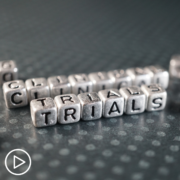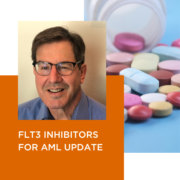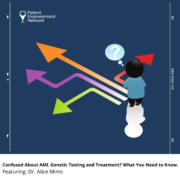Underrepresented AML Clinical Trial Groups | What Solutions Are Underway?
Underrepresented AML Clinical Trial Groups | What Solutions Are Underway? from Patient Empowerment Network on Vimeo.
What steps are being taken to help underrepresented acute myeloid leukemia (AML) clinical trial groups? Expert Dr. Andrew Hantel from Dana-Farber Cancer Institute and Harvard Medical School discusses an important approach that is being utilized to dismantle AML clinical trial barriers for underrepresented groups and proactive patient advice to work toward clinical trial engagement for all patient groups.
[ACT]IVATION TIP
“…patients of really any group to say kind of to their physicians, ‘How are people like me being engaged in research, and is there anything that I can do to help the groups that I identify with be more engaged in the research that is taking place, so we can really move the field forward and make sure that cures are happening for everybody?’”
Download Resource Guide | Descargar guía de recursos
Related Resources:
Transcript:
Lisa Hatfield:
Dr. Hantel, for patients who belong to a racial or ethnic group that are underrepresented in clinical trials, what steps are being taken to address this issue among you and your colleagues?
Dr. Andrew Hantel:
That’s a great question. So there are a number of efforts being made in our community to increase diversity in AML clinical trial enrollment, and I really think we are taking on what’s called a multi-level approach, meaning that we need to target things at different levels, the level of the patient, the level of the doctor and the research team, the level of how trials are designed to the level of the hospital, level of the community, and then the level of the government or the regulatory people, and just working on one of those levels is really going to fix things and so we are starting to kind of chip away at the problems that exist at each of those levels, that are really stopping underrepresented groups from being represented in clinical trials.
A few examples of these are things like community engaged trial development, where we are linking clinical trial investigators to community members to collectively design trials that really lower some barriers to entry, like eligibility criteria, and then to look at where they’re actually planning on opening up their trials to make sure that they are in communities who have been historically underrepresented, we’ve also set up some monitoring systems since…You may be surprised where they actually haven’t been good systems for telling hospitals, telling researchers, telling doctors, who am I enrolling versus who am I actually seeing as a patient and who’s being seen at our hospital versus who lives in the community that the hospital serves.
Really without that basic information, doctors and researchers can’t really have an idea in any real-time sense of how well or how poorly they’re doing at enrolling equitably. And we’re trying to do the best for our patients. And a lot of this is kind of inadvertent exclusion, but I think unless you present those data to people, they are likely going to assume it’s going well or that the problem kind of exists elsewhere, and they can’t do any better. And so I think linking that down to the program and the hospital actually gives them buy-in as to, “Oh, this is something that I’m doing, this is by a responsibility.”
There are also programs that we’re working on to train culturally diverse research staff and physicians, since a lot of research teams don’t look too much like their patient communities. And finally, we are creating educational programs with patient advocates and community organizations to educate patients about AML and about trials to make sure that they’re well-informed, have a place to go for answers, and all of this together really leads to lowering barriers, expanding access and making the system more inclusive and reflective of the community.
So my activation tip for this would be for patients of really any group to say kind of to their physicians, “How are people like me being engaged in research, and is there anything that I can do to help the groups that I identify with be more engaged in the research that is taking place, so we can really move the field forward and make sure that cures are happening for everybody.













